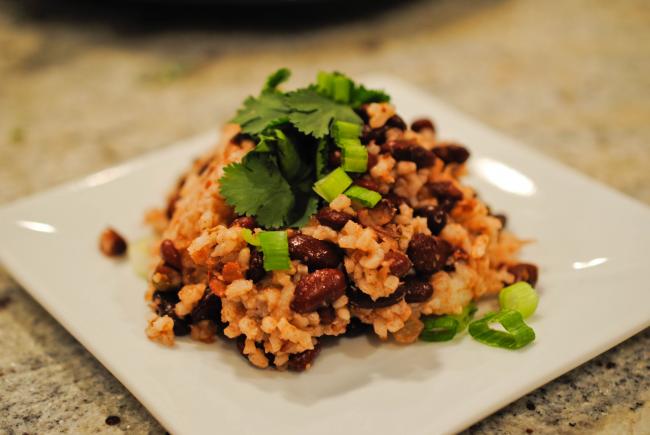You Are What You Eat: The $4 meal
Red beans and rice for under 46 cents.
Tue, 04/14/2015
By Katy Wilkens, MS, RD
Many attribute the rising incidence of obesity in the United States to the cheapness of fast food and the relatively high cost of healthy food. One difference between these two kinds of meals is that “healthy” takes time and “fast” doesn’t. But it’s a matter of paying now or paying later. Those fast food meals may save you time now, but they will lead to obesity and other health problems, taking years off your life and your family’s lives. This is not a great way to save money in the long run.
Eating healthy doesn’t have to be expensive. You can save money and eat healthy on less than $4 a meal for four people if you shop wisely:
1. Buy fruits and vegetables when they are in season. They will be cheaper, higher in vitamins and more flavorful.
2. Make your own salad dressing with oil, vinegar and spices. You will save money and avoid a lot of unhealthy salt.
3. Use coupons. Watch your mail or the newspaper for flyers. You can get coupons for many stores on your smartphone as well.
4. Use store brands. They’re generally a better deal. Often they’re made in the same plant as the name brand, and only the label is different.
5. Shop from a list. Studies show that people without a list spend almost twice as much money as people with a list. Keep a list stuck to your refrigerator and jot down things you are out of, so you don’t have to make so many trips to the store.
6. Plan for meals with ingredients you have on hand all the time. Have three meals that you can cook in 15 minutes or less and keep the ingredients needed on hand. When you get home late, you won’t be tempted to swing into the drive-through because a better, cheaper and healthier meal is waiting at home.
7. Eat before you go grocery shopping. You will stick to your list and be less tempted by high-fat, high-salt, high-sugar foods that are expensive and low in nutrition.
8. Buy in bulk when it makes sense. If you use a lot of oatmeal, get a big container. If you don’t use it as fast as you expect, oatmeal will keep a long time. But buying a large container of milk when you won’t use it all can be wasteful. Try using powdered milk in cooking to save even more money.
9. Buy all your spices and seasonings in bulk. Spices will be fresher and you’ll save money by reusing your own containers.
10. Check the Sparkpeople website to see what $20 will buy. Visit Compare $20 of fast food with healthy choices.
Keep ingredients on hand for delicious red beans and rice. For less than 50 cents per serving, you can fill up on a tasty meal. Your wallet and your healthy body will thank you.
Red beans and rice
1 teaspoon oil
1 onion, chopped
½ green pepper, chopped
1 clove garlic, minced
1 teaspoon ground cumin
1 tablespoon low-sodium chili powder
2 cans low-sodium canned kidney beans or one pound dried kidney beans soaked in water overnight
1 large can low-sodium tomatoes
1 fresh jalapeno pepper, minced or ¼ teaspoon cayenne pepper (optional)
5 cups hot cooked brown rice
Cost per serving: 48 cents
If you’re using dried beans, put them in a slow cooker and cover with water in the morning. Turn on low and cook 8 or more hours.
Sauté onion, pepper and garlic until translucent, about five minutes. Add spices, tomatoes and jalapeno. Rinse and drain canned beans, or use your slow-cooked beans. Add to sauce, heat a few minutes and serve over brown rice.
Serve with a green salad with oil and vinegar dressing and fresh tangerines.
Nutritional information (per serving):
Calories: 485, Carbohydrates: 92 grams, Protein: 24 grams, Sodium: 57 milligrams
The information in this column is meant for people who want to keep their kidneys healthy and blood pressure down by following a low-sodium diet. In most cases, except for dialysis patients, a diet high in potassium is thought to help lower high blood pressure. These recipes are not intended for people on dialysis without the supervision of a registered dietitian.
[Katy G. Wilkens is a registered dietitian and department head at Northwest Kidney Centers. The 2014 recipient of National Kidney Foundation Council on Renal Nutrition’s Susan Knapp Excellence in Education Award, she has a Master of Science degree in nutritional sciences from the University of Washington. See more of her recipes at www.nwkidney.org.]


